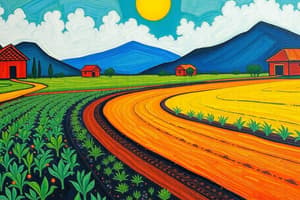Podcast
Questions and Answers
Which of the following factors significantly contributes to higher crop production in unfavorable climates?
Which of the following factors significantly contributes to higher crop production in unfavorable climates?
- Irrigation facilities (correct)
- Traditional farming methods
- Natural rainfall
- Fertile soil
In developed countries, agriculture is primarily characterized by traditional farming methods.
In developed countries, agriculture is primarily characterized by traditional farming methods.
False (B)
What is the primary purpose of agricultural development?
What is the primary purpose of agricultural development?
To increase farm productivity and ensure food security.
Rice is predominantly produced in ______.
Rice is predominantly produced in ______.
Match the following crops with their corresponding regions:
Match the following crops with their corresponding regions:
Which of the following is a type of subsistence farming?
Which of the following is a type of subsistence farming?
Commercial farming primarily involves the use of modern technology and is aimed at market sales.
Commercial farming primarily involves the use of modern technology and is aimed at market sales.
What is the primary purpose of agriculture?
What is the primary purpose of agriculture?
__________ is a form of agriculture where a single crop is grown on large estates for sale.
__________ is a form of agriculture where a single crop is grown on large estates for sale.
Which country is NOT a major producer of rice?
Which country is NOT a major producer of rice?
Shifting cultivation is also known as 'slash and burn' agriculture.
Shifting cultivation is also known as 'slash and burn' agriculture.
Name two factors that influence agriculture.
Name two factors that influence agriculture.
Match the following crops with their major producers:
Match the following crops with their major producers:
Flashcards are hidden until you start studying
Study Notes
Definition of Agriculture
- Agriculture involves cultivating soil, growing crops, and raising livestock for food, fiber, and other products.
- It serves as the primary source of food and raw materials, especially in developing nations like India.
Types of Farming
- Subsistence Farming:
- Aimed at feeding the farmer's family with small farms and limited technology.
- Common crops include wheat, rice, and vegetables.
- Commercial Farming:
- Focused on large-scale crop production for sale in the market.
- Utilizes modern technology, fertilizers, irrigation, and pesticides.
- Shifting Cultivation:
- Known as "slash and burn," involves clearing forest land and moving after soil depletion.
- Plantation Agriculture:
- A type of commercial farming growing a single crop on large estates (e.g., tea, coffee, rubber).
- Requires significant capital, modern technology, and skilled labor.
Major Crops
- Food Crops:
- Rice: Predominantly grown in tropical and subtropical regions; major producers include India, China, and Southeast Asia.
- Wheat: Needs moderate climate; leading producers are the USA, Canada, Argentina, Russia, and India.
- Millets: Thrives in poor soil; includes sorghum, bajra, and ragi.
- Maize: Cultivated in tropical and subtropical regions, with the USA, China, and Brazil as top producers.
- Fiber Crops:
- Cotton: Grown in warm areas with moderate rainfall; major producers are the USA, China, India, and Brazil.
- Jute: Flourishes in hot, humid environments; India and Bangladesh are the top producers.
- Beverage Crops:
- Tea: Grows well in heavy rainfall and humid climates; significant producers are India, China, and Sri Lanka.
- Coffee: Thrives in tropical highlands; Brazil, Vietnam, and Colombia lead in production.
Factors Influencing Agriculture
- Topography: Types of terrain dictate suitable crops; plains favor crops, while hills are suitable for tea and coffee.
- Climate: Temperature, rainfall, and humidity influence crop viability.
- Soil: Fertile soil with adequate nutrients is crucial for crop growth.
- Irrigation and Technology: Advanced irrigation and technology enhance productivity even in challenging climates.
Agricultural Development
- Agricultural development aims to boost farm productivity and ensure food security.
- Methods include improved farming techniques, better seeds, irrigation, fertilizers, and pesticides.
- Developed countries utilize highly mechanized agriculture; developing nations often rely on traditional methods.
Global Distribution of Major Crops
- Rice: Predominantly produced in Asia (India, China, Southeast Asia).
- Wheat: Majorly grown in North America, Europe, and Australia.
- Maize: Top producing regions include the USA, Brazil, and China.
- Coffee and Tea: Majorly produced in South America (Brazil) and South Asia (India, Sri Lanka).
Conclusion
- Agriculture is essential for sustaining a significant portion of the global population.
- Technological advancements and improved farming practices aim to meet the demands of a growing population.
Studying That Suits You
Use AI to generate personalized quizzes and flashcards to suit your learning preferences.




